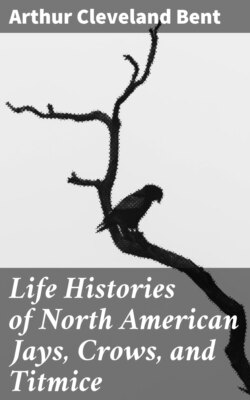Читать книгу Life Histories of North American Jays, Crows, and Titmice - Arthur Cleveland Bent - Страница 9
DISTRIBUTION
ОглавлениеRange.—Northern North America south to New York, Minnesota, New Mexico, Arizona, and Oregon; not regularly migratory.
The range of the Canada jay extends north to northern Alaska (Kobuk River, Chandlar River, and Demarcation Point); Mackenzie (Horton River, Dease River, Fort Enterprise, and Fort Reliance); northern Manitoba (Du Brochet Lake, Fort Churchill, and York Factory); northern Quebec (Great Whale River and Chimo); and Labrador (Nain). East to Labrador (Nain and Rigolet); Newfoundland (Fogo Island and Salmonier); and Nova Scotia (Baddeck, Kentville, and Barrington). South to southern Nova Scotia (Harrington and Grand Manan); Maine (Milltown, Foxcroft, and Norway); northern New Hampshire (Mount Washington); northern Vermont (St. Johnsbury and Mount Mansfield); northern New York (Long Lake, Fulton Chain, and Watertown); southern Ontario (Latchford, North End, and Sudbury); northern Michigan (Pickford and McMillan); northern Wisconsin (Spring Creek); Minnesota (Mille Lacs Lake and White Earth); southwestern South Dakota (Elk Mountain); northern New Mexico (Cowles and Baldy Peak); and east-central Arizona (White Mountains). West to eastern Arizona (White Mountains); northeastern Oregon (Blue Mountains); southeastern Washington (Blue Springs); northern Idaho (Coeur d’Alene and Clark Fork); British Columbia (Midway, Horse Lake, Hazelton, Flood Glacier, and Atlin); and Alaska (Iliamna Pass, Nushagak, St. Michael, Nulato, and Kobuk River).
The range as outlined is for the entire species. Three races are currently recognized and others have been proposed. The typical sub-species, known as the Canada jay (Perisoreus c. canadensis), occupies the major portion of the range from northern Mackenzie and central British Columbia east to Labrador, Newfoundland, and Nova Scotia; the Rocky Mountain jay (P. c. capitalis) is found in the Rocky Mountain region from southern British Columbia and Alberta south to Arizona and New Mexico; while the Alaska jay (P. c. fumifrons) occurs throughout Alaska except the coastal region east and south of the Alaska Peninsula.
The ranges of other subspecies are given under their respective names.
Casual records.—In fall or winter the Canada jay will sometimes wander south of its usual range. There are several records for Massachusetts (Amesbury, Quincy, Mount Greylock, Arlington Heights, Bernardston, Cambridge, and Newton). It was recorded from Utica, N. Y., in the winter of 1868-69 and was seen repeatedly at Cortland, in that State, during January 1928. Audubon reported one from Philadelphia, Pa., in October 1836. In Minnesota it has been noted in winter irregularly in the southern part of the State (Hennepin, Ramsey, Washington, and Anoka Counties); and there are several records for Nebraska (West Point in the late winter of 1886, near Fort Robinson in April 1891, head of Monroe Canyon in February 1896, near Belmont in the spring of 1889, and Antioch on February 2 and 26, 1930).
Egg dates.—Alaska: 2 records, April 10 and May 13.
Alberta: 56 records, March 11 to April 21; 28 records, March 18 to April 8, indicating the height of the season.
Colorado: 6 records, March 17 to April 30.
Labrador: 5 records, March 20 to April 23.
Newfoundland: 17 records, April 4 to 30; 9 records, April 10 to 16.
Nova Scotia: 9 records, April 2 to May 7.
